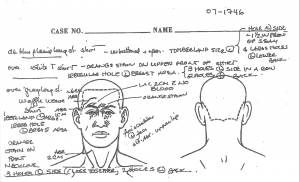Thirteen years after police shot and killed an 18-year-old in Maine, an independent review board has been tasked by the state attorney general with a new investigation into whether the shooting was justified.
New information released in a July press conference held by the Lincoln County district attorney and local advocates raised questions about the legitimacy of the original investigation into the shooting. Despite some pushback over the summer, the attorney general’s office agreed to revisit the case in October. The review board’s decision is expected within the coming weeks.
Since the state attorney general began reviewing police use of deadly force cases in Maine in 1990, it has never ruled a shooting unjustified. The decision by the board could lead to the first time in Maine history that one of these rulings is reversed.
The Shooting
After hanging out and drinking with his cousin on a Saturday night in 2007, 18-year-old Gregori Jackson of Whitefield, Maine, called a friend for a ride to go buy some cigarettes. Jackson’s friend lived nearby and came over right away. About an hour and a half later, the three of them were on their way to the local, 24-hour gas station on Sept. 23.
According to public records, Jackson entered the gas station, bought a pack, and hopped back into the passenger seat of his friend’s 1995 Red Pontiac. He offered his friend $20 for the ride, saying the only other thing he wanted to do before heading home that night was to drive around a bit with the windows down.

At approximately 2:14 a.m., Waldoboro Police Reserve Officer Zachary Curtis turned on his lights and sirens and began pursuing the vehicle. In the police report filed that night, Curtis stated the vehicle did not fully stop at a stop sign and crossed over the centerline of the road five to six times, although he would change his story multiple times later on.
Jackson’s friends would later tell officers that, when they saw the lights behind them, Jackson became visibly worried and said, “oh my God, oh my God, we’re getting pulled over.” He was on bail for a DUI from earlier that year, and one of the provisions forbade him from carrying or using drugs or alcohol.
Curtis stated in the police report that Jackson repeatedly failed to provide his identity, and he smelled a strong scent of alcohol on Jackson. When Jackson finally told Curtis his real name, the officer said he ran a background check on the spot to determine if the 18-year-old was “wanted” by local police.
When Curtis returned to the vehicle, Jackson reportedly admitted that he was aware of his bail provisions. Curtis removed Jackson from the vehicle and informed him he was under arrest. When the officer tried to handcuff Jackson, Jackson pushed off from the car and sprinted into the woods.
The story of what occurred that night from this point forward is told only from the view of Officer Curtis, and remains disputed, but newly released evidence has shed light on a series of facts that put the officer’s story into question.
According to the police report, Curtis chased Jackson into the woods, where Jackson repeatedly attacked him. Curtis said he feared for his life, and he proceeded to shoot Jackson five times at close range.
A postmortem review from the then deputy chief medical examiner, Dr. Marguerite DeWitt, found that Jackson had been shot three times in his left side, once through his spine, and once in the back of the head.
The officer’s use of force was ruled justified by the Maine state attorney general, and the lawsuit from Jackson’s family was dropped in 2010. Curtis was unable to be reached to provide comment for this story. But according to a 2019 interview with the Jackson family’s lawyer, when asked what he would change if things could be done differently, Curtis said while he “can always second guess” decisions made in the moment, there was “no way to know” how the situation would have turned out.
The Evidence
Since the Maine Office of the Attorney General was given the responsibility of investigating police use of deadly force in the state, it has never found an officer-involved shooting unjustified.
But, the current Lincoln County District Attorney Natasha Irving said it should have been clear at the time that this case was different.
“The dead body and the statements of the police officer were not in accord, they were completely contrary,” she said.

Irving became the DA in 2018, running on a restorative justice platform. She was a resident of the town prior to her election, and she said she was “appalled” by the shooting when it occurred.
“My belief at the time … was that this was a cop that shouldn’t have chased that kid into the woods, and he got himself into a bad situation and ended up shooting him in the back, and it shouldn’t have happened,” said Irving. “After reviewing [the case], I did not believe that the way that the officer said it happened was possible.”
Irving said the attorney general’s record of finding cases justified could give bad cops an expectation that they are able to use deadly force without fear of repercussion.
The police report, filed by Curtis, stated that he had been repeatedly physically assaulted by Jackson both with his fists and with logs picked up in the woods. But, when Irving reviewed the case file, she said she found no evidence that Curtis had been injured aside from three small bruises. She also saw in the medical report that Jackson had no bruising or damage on his hands or forearms, typical injuries found when a person has been in a fight.
According to the medical examiner’s report, the first shot that entered Jackson’s body immediately severed his spinal cord. Curtis said Jackson was belligerent and did not appear to be affected by his first shot, but Irving said she finds it “hard to believe” that an individual with severe spinal injury, even drunk, could continue to fight or attempt to flee.
To Irving, the most damning alleged inaccuracy in Curtis’ story is blood patterns at the crime scene. In the police report, Curtis described the moment at which he began shooting Jackson saying Jackson had tackled him to the ground, was on top of him beating him over the head, and was trying to take away his firearm.

“Now, if you examine the body, and you see the pictures, you can see that the first shot that entered Gregori Jackson’s body exited through the center of his chest and caused extensive bleeding, it turned his white shirt completely red,” Irving said. “And Officer Curtis did not have any blood on his uniform except for what was described as a minute splatter on, I believe, his right upper arm on his badge.”
“Minute splatter,” according to Irving, is defined as blood splatter so small it cannot be seen by the naked eye and can only be detected by using a microscope.
The Culture
After reviewing the evidence, Irving said she is confident that revisiting the case, even 13 years later, could easily lead to a homicide conviction. But, this leaves the question: if the case is so clear cut, why was it ruled justified in the first place?
State Representative Jeffrey Evangelos has been fighting to improve police accountability in Maine ever since he learned of Jackson’s death in 2007. Last November, Evangelos helped pass a bill he’s repeatedly introduced for over a decade that requires independent reviews of all state police shooting investigations.
Evangelos said the bill was inspired by the “cover-up” by the Waldoboro Police Department and the Attorney General’s office in the investigation into Jackson’s death.
“This family needs justice, just like any family would,” Evangelos said. “An unarmed boy took five bullets in the back, and he didn’t do anything.”
Through public records requests, Evangelos submitted years ago on behalf of the Jackson family, he found a letter dated June 1, 2007, addressed to Jamie Wilson, the acting police chief of the Waldoboro Police Department. It showed the state planned to de-certify Officer Curtis prior to the shooting because he was “unfit to serve.” The letter said Curtis had only completed 100 of his 700 required training hours.
However, the letter signed by Maine Criminal Justice Academy Chairman Brian MacMaster, said that because the department was low on officers, the “extenuating circumstances” of the situation were enough to give Officer Curtis an extension until Sept. 30, 2007. Curtis shot and killed Jackson seven days before he was scheduled to be removed from the force.
After an extended leave following the 2007 shooting, Curtis returned to the force only to surrender his law enforcement license in 2009 after he was accused of theft by the department, which he admitted to in the 2019 interview. He then became a dispatcher for Knox County, but was fired and fined $500 after being convicted of tampering with public records in 2013.
“You had not only an inexperienced and unqualified police officer, you had a police officer who has very, very violent tendencies, who should never have been an officer,” Evangelos said. “You [also] had an investigation stymied by massive conflicts of interest.”
Brian MacMaster has been the Maine state attorney general’s chief investigator since 1990. He investigates and makes rulings on all police shootings. Because MacMaster was responsible for Curtis’ continued time on the force and was in charge of the investigation into Curtis’ shooting, Evangelos said he believes MacMaster had a vested interest in ruling the case justified.
“They should have known right then that this one was in trouble,” Evangelos said. “But they just hammered it through like they do every time, 170 to nothing, that’s our score here in Maine.”
Since 2009, police have used deadly force against 69 people. Of them, 55 were armed with either a firearm, a knife or a blunt weapon. Five were thought to be armed but were later determined to be wielding either a pellet gun or another object mistaken for a firearm. Nine were unarmed.
Although laws have changed to require more training and more stringent reviews of police use of deadly force by the state and independent, citizen-run panels, the number of shootings in the last ten years has increased.
After a spike in 2017, where 13 people were shot by police in Maine, the state began an internal investigation into the increase in the use of deadly force. The Task Force to Review Deadly Force Incidents by Police examined 10 incidents from recent years and identified that the majority of individuals shot by police were drunk, mentally ill or both.
The attorney general’s office conducts investigations into these reports that regularly span two or even three years before a final decision is made. But, Jackson’s investigation was completed in only a little over two months.
When District Attorney Irving decided to take Jackson’s case, she found that the medical examiner had never been interviewed during the investigation, which she said is standard practice whenever dealing with a case that isn’t “crystal clear.”
She declined to comment extensively on the handling of the case by the Waldoboro Police Department, but she noted that there was some “fishy stuff” that happened that night. She said some “very, very standard protocols” when handling evidence were violated by the department.
The medical examiner told Irving she had bagged Jackson’s hands, a common practice with homicide cases, had placed shell casings in the body bag and had, as with everybody, zipped the body bag shut and tagged it.
She said “between the removal of the body from the scene and delivery of the body to the medical examiner’s office” the casings were removed, the tag was broken and the bags conserving Jackson’s hands were removed.
“You have the physical evidence versus the testimonial evidence that doesn’t comport, at least from my perspective, you know, why are we covering for a bad cop?” Irving said.
As of October, the Maine attorney general’s office has allowed an independent review board from New Hampshire to examine their original investigation. Their findings are expected to go public in the coming weeks.
MacMaster declined to comment on this story, but he said in an email that the final decision from the independent review of the case is “forthcoming.”





Add comment